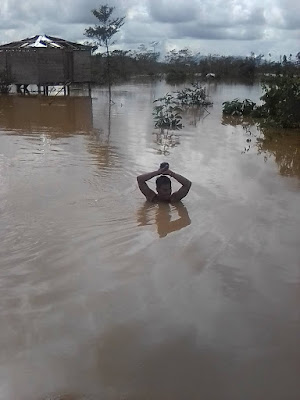On November 3, much of the world's attention was on the U.S. election day. In Central America on the same day, people braced for Hurricane Eta, which entered Nicaragua's northeast coast as a Category 4 hurricane. People had been fairly successfully evacuated from vulnerable areas and there were very few deaths in Nicaragua, although many crops and roofs were damaged. The storm then turned north, weakening in its windspeed but continuing to rain extraordinary amounts. As the storm passed through the mountainous central Honduras and continued north, the water converged around the Sula valley which led to flooding up to people's rooftops. The storm then lead to flooding and landslides in Guatemala, and even continued up north to Cuba and Florida.
José Hernández, a Mennonite pastor who lives in the Chamelecón area, was with church members on the second floor of the church's classroom building, where they waited during two days until the waters receded enough to leave. (pictured below)
Our area directors, Cesar and Lizette, attend the Iglesia Central Menonita in San Pedro Sula, and their church members quickly organized to offer their church building as a temporary shelter to people affected in the Chamelecón and Rivera Hernandez areas. People were eager to get back and start cleaning up, and MCC offered some initial support with wheelbarrows, shovels, food, and hygiene. They found homes covered in mud and furniture and appliances had floated around their homes and even out into the neighborhood. At the same time, MCC also began conversations with other partners in Honduras, Nicaragua, and Guatemala about responses in other affected areas.
Unfortunately, as the clean-up progressed and NGOs evaluated and prioritized the damages and needs, Central America became anxious again about another storm brewing in the Caribbean. On November 16, Hurricane Iota entered Nicaragua just south of where Eta had hit, but Iota's epicenter was much wider. Iota reached category 5 windspeeds at sea, and hit land as category 4. Nicaragua had evaluated some 50,000 people again, but this time there would be more deaths. The storm hit already saturated land, and the flooding and damages were more extensive. The storm had a more direct path westward than Eta, so areas that had escaped Eta got hit by Iota. The Sula valley saw the same extraordinary levels of flooding. Across the region, we heard about exhaustion and discouragement among NGO workers and church volunteers who were working with shelters and clean-up from these back-to-back storms.
In Nicaragua, there is a joint committee between three Anabaptist conferences for disaster response, and they had contacts in the northeastern area known as the mining triangle. I made a call to one of the church pastors who was sending pictures through WhatsApp. I learned he was sending the pictures directly from his phone, as he floated around the area on what I would later understand was a simple raft. (pictures below)
There were homes that withstood the winds, but also ones that were blown over and many lost metal roof sheets. In many of these areas there are concerns about flooded latrines and contaminated wells.
As for us here in Managua, we had heavier rains during Iota than Eta, and there were a couple trees down along our street. The government's disaster monitoring declared a 'yellow' category, which led to our children's school being closed one day. We know of some homes that were damaged nearby, however, in the city itself, the rains weren't so different than other thunderstorms that happen here.
We were encouraged by the financial sharing and encouragement that people offered, even after a challenging year in which resources are limited. MCC is collaborating on multiple responses with different organizations and church groups across Nicaragua, Honduras, and Guatemala.



